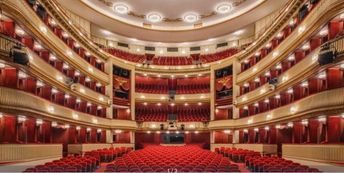Philip Johnson: "The New York State Theater was designed with Classicism in mind. When I began to plan the ballet theater in the 1950s, I felt I was being pretty reactionary. I found my inspiration mainly in eighteenth-century rococo theaters in Bavaria, and felt the ballet theater should resemble a state theater from that time. The reason was simple: in those festival spaces one gets the unmistakable feeling that there is no place but the cheater. Though I was reaching back to an earlier century, I also had to deal with contemporary problems, like having the maximum number of seats in the auditorium. Decent rococo theaters seat four to five hundred. We had to seat three thousand." [1]
“Were you thinking of any distinct models when you were putting the design together?
Yes, I was thinking of eighteenth-century theaters. I was also looking at specific books on theaters, in particular, a German book on the history of theaters, 'modern' theaters. It was by Gottfried Semper, I think. The book ended with his work in Dresden [pictured left] and Vienna [pictured right]. Of course, I also looked at Charles Garnier, the architect of the Paris Opera House.” [2]
Below you see the three theaters that Johnson referenced above, and his own theater. The similarities are obvious. The red seats, the shallow, golden balconies.
(top left) Semperoper -- Dresden, Germany, Gottfried Semper, 1841
(top right) Burgtheater -- Vienna, Austria, Gottfried Semper, 1888
(bottom left) Palais Garnier -- Paris, France, Charles Garnier, 1875 (Photo by Patrick Touneboeuf)
(bottom right) New York State Theater-- New York, Philip Johnson, 1964
In a 1965 NYCB souvenir program, Lincoln Kirstein compared Philip Johnson to Charles Garnier, the architect of the Paris Opera House: “Both architects, or rather artists, sculptors of space through enclosing forms, had fierce attachment to luxury, the lavish use of emptiness described by noble materials. Both considered the function of theater as fantasy, warmth, illusion; the grandiose possibility of the fantastic. Both felt that, for spectacle based on music, baroque architects had solved for all time the structural problem. Hence the New York State Theater is a classic opera-house.” [3]
[2] Philip Johnson: The Architect in His Own Words by Hilary Lewis and Philip Johnson
[3] Lincoln Kirstein in 1964-65 Souvenir Program
This post contains affiliate links.








Comments